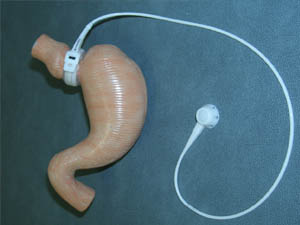Laparoscopic Adjustable Gastric Band
A laparoscopic adjustable gastric band (or LAP band as it is more commonly known) is a form of weight loss surgery for people who have a body mass index of over 40, or over 35 if they have health conditions caused by their obesity.
Laparoscopic surgery
Laparoscopic surgery is an extreme step and is usually only performed on people who have tried and been unsuccessful at many other methods of weight loss such as numerous diets and exercising. However LAP band surgery is the less invasive kind of weight loss surgery and the recovery rate is a lot faster than with open surgery.
When a patient undergoes LAP band surgery a small incision is made in their abdomen into which a laparoscopic camera is positioned. The camera transmits an image of the stomach to the surgeon and enables him to see the abdominal cavity clearly. The surgeon then creates a small tunnel at the back of the stomach in which he inserts the gastric band. He is then able to fix the band around the stomach.
When the band is in place this effectively separates the top part of the stomach. The top part of the stomach is 1/6 of the size of the full stomach and due to the band being in place, when the top part of the stomach is full the brain feels the whole stomach is full, thus enabling the patient to stop over eating and lose weight.
As the patient loses weight the band can be adjusted by injecting a saline solution into a small access point placed just under the skin. The more saline that is injected, the smaller the passage is between the upper and lower parts of the stomach, further restricting the movement of food. The number of adjustments required varies per individual.
Benefits and risks
There are numerous benefits to LAP band surgery when compared to other types of weight loss surgery. These include:
- Lower mortality rate. 1 in 2000 compared to 1 in 250 for gastric bypass surgery.
- No stapling or cutting of the stomach
- Fully reversible if required
- Quick recovery rate and short hospital stay
- Easily adjustable without further surgery
- Fewer life threatening complications
However LAP band surgery should not be decided upon lightly as there are still some risks. These include:
- Infections
- Internal bleeding
- Ulcers
- Gastritis
- Blood Clots
- Chest Pain
Effectiveness
The heavier the patient is, the greater the initial weight loss will be. However once the patient is losing weight consistently the weight loss tends to average at around one to two pounds a week. This is around 45 to 99 pounds a year - a drastic loss. The procedure also tends to encourage patients to change their lifestyle and also start to eat better. The more the patient introduces exercise and a healthy diet into their life the more effective the LAP band surgery is. LAP band surgery has been proven to help with long term weight stability.

